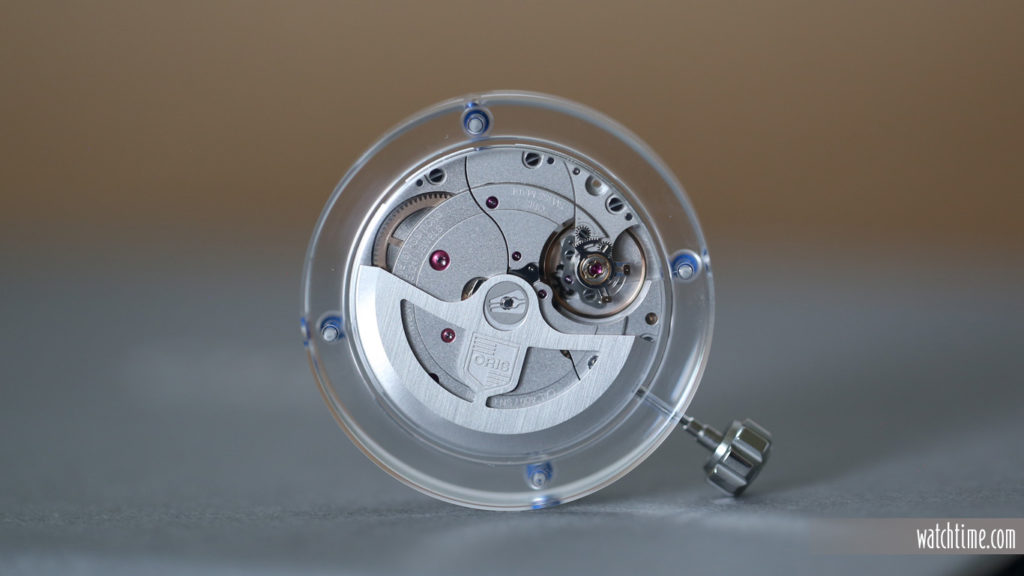Oris is one of the busiest brands in the market. With a steady stream of watch releases throughout the year, involvement in almost every major horological event, a collection of impressive charitable efforts, and numerous eye-catching collaborations, the Holstein-based watchmaker is consistently impressing us with its work. This past week, Oris once again demonstrated its impressive work ethic, unveiling a new, in-house, automatic movement, the Oris Caliber 400.

As our regular readers know, we rarely cover announcements of new movements without new watches to accompany them, but the Oris Caliber 400 merits a closer look, as it is positioned to significantly upgrade the brand’s entire catalog of watches. It is also Oris’s first in-house automatic caliber, coming as a solid sequel to its much-discussed 110 series of hand-wound calibers first released in 2014 — and which now includes five distinct combination of complications within the family (Caliber 115, used in the Oris Big Crown ProPilot X Calibre 115, is pictured below).

Taking a closer look at the new Caliber 400, we find a self-winding, antimagnetic mechanism that Oris has clearly put some serious engineering dollars and talent into. At its core, power is delivered to the watch via two mainspring barrels, with the design of the gear train intended to reduce energy inefficiencies throughout, which in combination with the various silicon parts used throughout further enhance the energy transfer through the mechanism. According to the brand, a typical automatic movement delivers about 70 percent of the mainspring barrel torque, where the Caliber 400 achieves 85 percent deliverance. Efficiency is the name of the game with this movement, which even eschews the typical ball bearings used in automatic winding systems in favor of a new sliding-friction clip system, which Oris claims will significantly reduce failures over time.

The movement also boasts exceptional anti-magnetism, having been stress-tested by the brand to resist up to 2,250 gauss. This degree of anti-magnetism is achieved largely by the use of amagnetic materials throughout the movement, used on 30 individual parts including critical components such as the balance, escape wheel, and lever. To place these capabilities in context, the Rolex Milgauss — a watch often considered one of the prime examples of anti-magnetism — has an antimagnetic resistance up to 1,000 gauss.

In addition to the antimagnetism, the caliber features an impressive five-day power reserve that is sure to make fans of the brand quite happy as they’ll more easily be able to place the watch down for a few days without having to worry about it running out of juice. Additionally, Oris is backing up the movement with a 10-year warranty and service suggestion, meaning your watch could go up to 10 years between servicing — for many collectors, another major draw to any watch containing it.

As this announcement only encompasses the new movement, it is highly likely the brand will soon unveil a range of both new and familiar watches containing the caliber. Rolf Studer, CEO of Oris, indicated as much when he told WatchTime Editor-in-Chief Roger Ruegger earlier this year that the brand will continue to offer its standard mechanical option as well as the upgraded in-house mechanism. Speaking to this likelihood, Studer went on to discuss pricing, indicating that watches containing the manufacture caliber are expected to be about 30 percent more expensive than those using a brand-standard Sellita mechanism. “It’s understandable that the average price of a watch tends to rise as a result [of an in-house movement],” Studer said, “but we continue to offer customers the option of choosing between a watch with the familiar [Sellita] calibre or the new automatic movement.”

The new Caliber 400 will be placed on full view at this year’s WatchTime Live event, and will be the first live opportunity collectors will have to see the interesting new mechanism. The movement is expected to share the spotlight with another recent Oris release, the Roberto Clemente Limited Edition Big Crown, at this year’s event, though as far as we know the Big Crown model continues to use the standard Sellita-201 base caliber.
For more information on the new caliber, you can visit Oris’ website, here.
WatchTime Live is happening now! For the full schedule of events, you can visit the event website, here.







This reply is somewhat off subject matter, but can anyone make a stab at estimating the value of having a Rolex Datejust 41, arriving to the purchaser in a 40mm oyster case? This Rolex appears to be absolutely genuine down to the 3235 movement…
Thanks for any help…